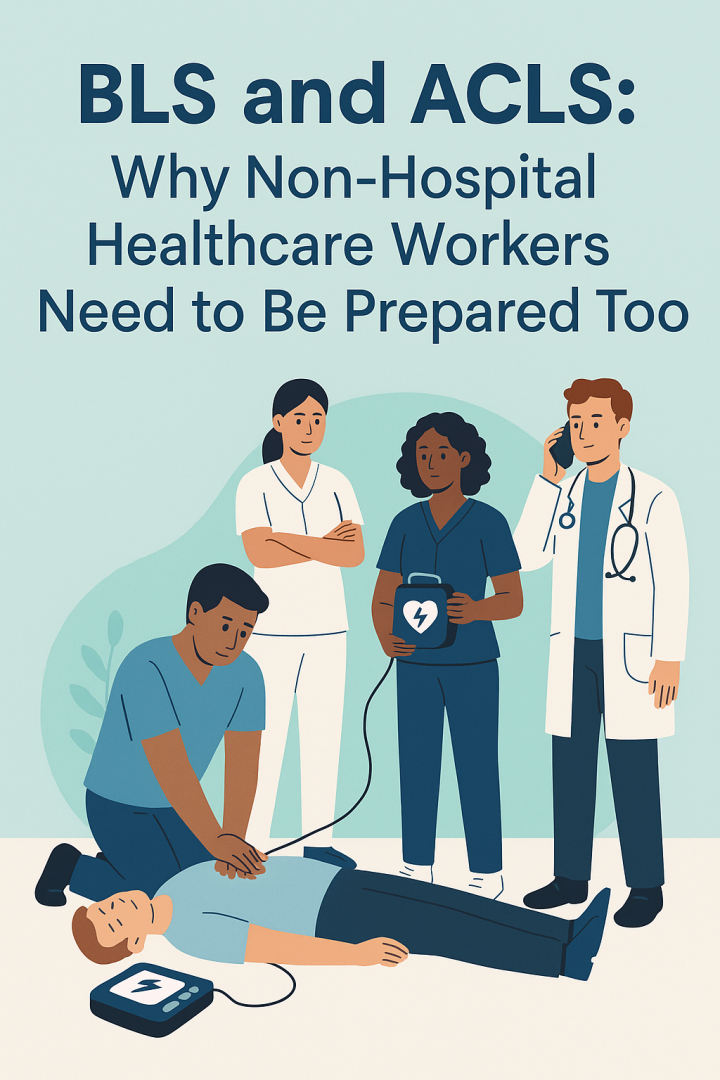Introduction
When we think about life-saving interventions like Basic Life Support (BLS) and Advanced Cardiovascular Life Support (ACLS), hospitals and emergency rooms naturally come to mind. But cardiac arrests and medical emergencies don’t always wait for the perfect setting. For non-hospital healthcare workers—such as those in outpatient clinics, dental offices, nursing homes, rehabilitation centers, home health, and even urgent care facilities—being equipped with BLS and ACLS skills can make all the difference between life and death.
Why BLS/ACLS Matters Outside the Hospital
- Emergencies Can Happen Anywhere
Sudden cardiac arrest, respiratory failure, or other medical emergencies don’t exclusively occur within hospital walls. Patients in outpatient settings, waiting rooms, or even during routine procedures can experience life-threatening events. - Time Is Critical
In a cardiac arrest, every second counts. Immediate, high-quality CPR and early defibrillation can double or triple a person’s chance of survival. Non-hospital staff are often the first responders in these scenarios—before EMS even arrives. - Patient Trust and Safety
Patients expect a safe environment no matter where they receive care. Knowing that staff are trained and prepared to respond to emergencies builds trust and reflects a strong commitment to patient safety. - Regulatory and Legal Standards
Many licensing boards and accreditation bodies require or strongly recommend BLS (and sometimes ACLS) certification depending on your role. It also provides legal protection by showing that staff were appropriately trained to handle emergencies.
Key Differences Between BLS and ACLS
- BLS focuses on immediate life-saving techniques including CPR, AED use, and basic airway management. It’s essential for virtually all healthcare personnel.
- ACLS builds on BLS with advanced interventions such as ECG interpretation, administering emergency medications, and managing complex cardiac rhythms. It’s typically required for providers who may lead or assist in cardiovascular emergencies, including RNs, physicians, and paramedics.
Who Should Be Certified?
Even if your primary role doesn’t involve critical care, certification is a smart move if you work in:
- Dental and oral surgery practices
- Dialysis centers
- Physical therapy and rehab facilities
- Urgent care clinics
- Long-term care or assisted living facilities
- Home healthcare agencies
Even administrative staff and security personnel in medical facilities can benefit from BLS training in case they are first on the scene.
Training Is Accessible and Practical
Certification courses are widely available, often through the American Heart Association (AHA) or the American Red Cross. Many programs offer blended learning options—online modules followed by in-person skill assessments—making it easier to fit into a busy work schedule.
Conclusion: Empowerment Through Preparedness
In the healthcare world, preparedness isn’t optional—it’s a responsibility. BLS and ACLS certification empowers non-hospital healthcare workers to act swiftly and confidently when seconds matter most. It’s more than just a requirement; it’s a life-saving skill set that reinforces your role as a vital part of the healthcare ecosystem.


